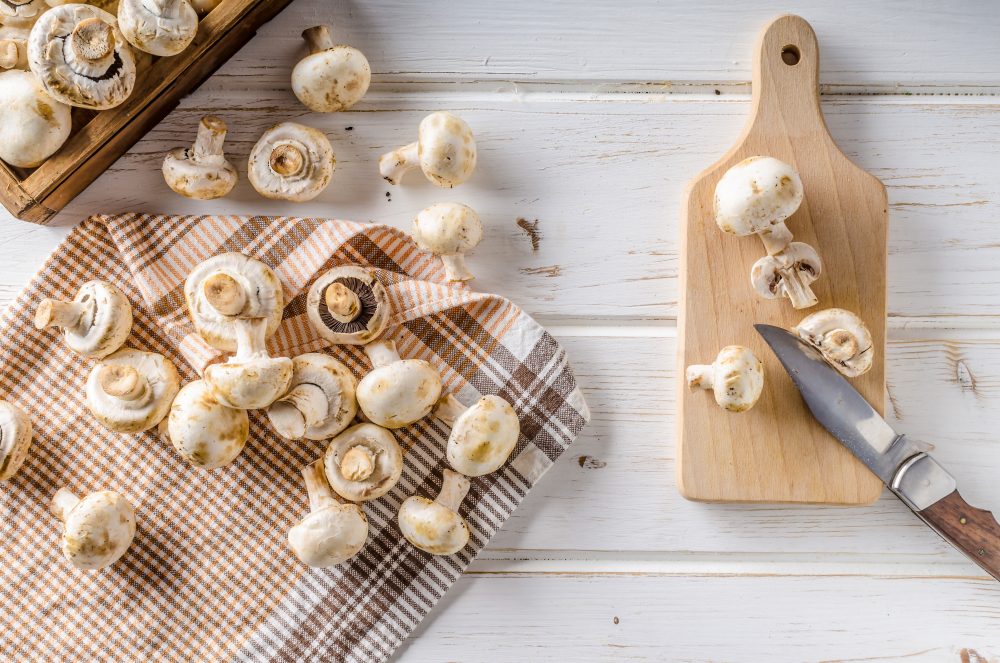Culinary heavyweights might tell you to never let mushrooms sit in water, lest they become waterlogged, but food writer Harold McGee debunked conventional wisdom on the water/mushroom conundrum in his 1990 book “The Curious Cook.” After soaking button mushrooms in water for a full five minutes, he found each mushroom absorbed an average of 1/16th of a teaspoon of water. Mushrooms may feel spongy, but think of them more like styrofoam—a little squashy, yes, but not likely to absorb anything meaningful.
That being said, how you prep mushrooms does matter. A late-in-life mushroom convert, I realized there was an ocean of difference between the gummy, wan specimens I picked out of childhood plates and the gloriously browned, meaty versions that could carry a whole dish. And to get the most umami-packed punch, really excellent mushroom prep starts with what we all ignore most: cleaning.
In honor of Milk Street’s Mushroom Week, I went down an internet rabbit hole—and asked some of our in-house experts—to explore how to prep the fungi so that they shine in recipes, without turning into the dreaded rubbery gray mush.
How dirty are mushrooms, anyway?
If they’re cultivated, probably not that dirty. Creminis, buttons and other commercially grown varieties are usually okay; a little compost or growing medium is usually what you see stuck to the cap or stem. Will it hurt you? Not likely, but these remnants may add a little something sandy to your recipe you weren’t expecting. There’s a little more risk to wild, foraged mushrooms, which may carry dirt, bugs or other forest flora and fauna in their folds.
To wash or not to wash?
If aesthetics matter, don’t rinse under running water. The force of running water can bruise a mushroom cap, leaving brown or gray stains where the cells have been rough handled. Not the most appealing if your mushrooms are being served raw.
But if you’re cooking your mushrooms, or dealing with a particularly dirty specimen, you can rinse them under the tap or gently swish them around in a bowl of clean water, then pat dry (or dry them in a salad spinner).
What should you do instead?
When in doubt, brushing with a damp paper towel or a soft, dry brush is the way to go. “It definitely takes more time to get a damp paper towel and individually clean each mushroom, but it’s worth it,” says Haley Laube, eCommerce Culinary Coordinator. This is great advice for a classically shaped mushroom (think stem and cap), and my cleaning method of choice for most of my mushrooms. Mushrooms that are wiped clean are easier and less slippery to handle when chopping, they’ll dry more quickly before cooking—I’m all for a technique that gets the job done faster.
How about special shapes?
Think lobster mushrooms, hen of the woods, maitake and the like—if they’re found in the wild, you may get them with other plant-life in tow, like shoots of grass or leaves grown in with them. Break the mushrooms up into as large of chunks as you can to remove anything you don’t want, then clean gently with a—you guessed it—damp paper towel. (For special mushrooms like these, the organic shape is part of the charm; if you can leave them chunkier once cleaned, that’s a great way to retain some meatiness.)
Morels are a special case. This wild mushroom has a distinct honeycomb-like exterior—a perfect hiding place for little worms. Even store-bought morels are wild and require attentive cleaning. Luckily, it’s a simple process. Fill a bowl with clean water and swish the mushrooms around in the water for about 10 seconds, letting the dirt and worms fall away. Remove them from the bowl and set them on a clean kitchen towel (or paper towels) to dry. (Do not drain them through a colander, you will end up with a colander full of mushrooms and worms.)
For floss-like mushrooms like enoki, trim the ends, pat clean between damp towels and proceed.
Do you need to peel mushrooms?
Again, the short answer is no. "I think peeling is a waste of time and really tedious, unless you’re in a Michelin-starred kitchen,” says Haley. Fine dining establishments might do it to achieve a particular goal—say, to provide a certain aesthetic or color to a dish—but reasons to do it at home are few and far between.
Mushroom – room? = Mush.
After all that work, let’s go over some mushroom pro tips to get the most out of your freshly cleaned fungi. Rule number 1: Don’t crowd your pan. If mushrooms don’t have sufficient room, they’ll steam—not sear—and go gray and rubbery.
Laube also suggests waiting to salt mushrooms until after you’ve seen them release their moisture and get a little color. That’s also a good time to add any liquids. For what it’s worth, changing when I salt my mushrooms has probably been the single tip that’s improved my mushroom cookery most. And for more on buying, storing and cleaning your mushrooms, see some of our tips in action on Instagram.
For more Mushroom Week content, learn how to grow your own lion's mane at home, then use them to make lion’s mane mushroom tacos; Read Hannah Packman’s favorite way to go meatless; Watch Rosie Gill make smoky "pulled" portobello mushroom sandwiches; And let Wes Martin teach you the proper way to clean mushrooms.
Join the conversation on Facebook, Instagram, TikTok and Pinterest.
And if you're looking for more Milk Street, check out our livestream cooking classes with our favorite chefs, home cooks and friends for global recipes, cooking methods and more.




